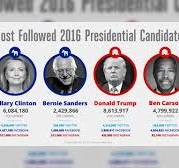Role of Social Media and Public Opinion in Shaping Political Dynamics

The role of social media is significant in shaping public opinion and political dynamics, especially in the context of US elections. It serves as a platform for political discourse, campaign promotion, and voter engagement. Here’s how social media is contemplated to influence the upcoming US elections:
- Voter Engagement: Social media has become a crucial tool for increasing civic engagement. It helps in voter registration drives and encourages people to vote. During the 2020 Presidential Election, social media was credited with contributing to record-breaking voter registration numbers and early voting1.
- Information and Misinformation: While social media can spread valuable information, it also has the potential to disseminate misinformation and disinformation. This can affect voters’ perceptions and decisions. Efforts to counteract false information are critical to maintaining the integrity of the election process1.
- Targeted Advertising: Political campaigns use social media to target specific demographics with tailored messages. This micro-targeting can significantly influence public opinion by reaching out to voters with personalized content that resonates with their beliefs and concerns.
- Youth Engagement: Social media is particularly influential among younger voters. Platforms like Twitter, Facebook, and Instagram are used to mobilize this demographic, which can be pivotal in close races.

Social Media Platforms - Real-Time Communication: Candidates and political parties use social media for real-time communication with the electorate. This allows for immediate responses to current events and the ability to shape narratives quickly.
- Fundraising: Social media campaigns are also effective tools for political fundraising, enabling candidates to reach a wide audience with calls for donations.
In the present scenario, with the increasing reliance on digital communication, social media’s impact on the US elections is expected to grow even further. It’s important for voters to critically evaluate the information they encounter online and for platforms to continue improving their measures to combat misinformation. The dynamic interplay between social media and public opinion will undoubtedly continue to evolve and play a crucial role in the political landscape.
Regulating social media during elections presents several challenges. Let’s explore some of these:
- Adapting Offline Regulations to Online Spaces:
- Applying campaign regulations designed for traditional media to social media platforms can be challenging. These regulations may not adequately address the unique dynamics of online campaigning
- For example, distinguishing between what constitutes advertising (subject to transparency requirements) and what does not can be complex. While taglines and ad registries provide information about responsible parties, they apply only to a subset of messages on the Internet during the election period2.
- Detecting and Addressing Harmful Information:
- The move toward closed and private social media spaces makes it difficult to detect harmful information spreading online. Monitoring public spaces across various languages is challenging, allowing harmful content to spread undetected2.
- Ensuring transparency about the source and content of advertising is crucial for accountability and trust in the electoral process.
- Misinformation and Disinformation:
- Social media platforms are susceptible to the rapid spread of misinformation and disinformation. False narratives can influence public opinion and voter behavior.
- Balancing free speech with the need to combat false information is a delicate task for regulators.
- Micro-Targeting and Personalization:
- Social media allows micro-targeting of specific demographics with tailored messages. While this enhances engagement, it can also create echo chambers and reinforce existing biases.
- Regulating personalized content without stifling legitimate discourse is a challenge.
- Foreign Interference and Manipulation:
- Social media platforms are vulnerable to foreign actors spreading disinformation during elections. Regulators must address this threat while preserving open communication.
- Striking a balance between security and free expression is essential.
- Enforcement and Accountability:
- Holding individuals and political actors accountable for violating regulations on social media can be challenging. Enforcement mechanisms need to adapt to the digital landscape.
- Ensuring transparency about funding sources and preventing illicit campaign financing is crucial.
- Privacy Concerns:
- Balancing transparency with privacy rights is essential. Social media users’ data can be exploited for targeted campaigning.
- Regulators must find ways to protect privacy while ensuring transparency.
In summary, regulating social media during elections requires a nuanced approach that considers the unique features of online platforms, addresses misinformation, and maintains transparency and accountability2.
Identifying misinformation on social media can be challenging, but there are strategies that voters can use to navigate this landscape. Here are some ways to spot false information:
- Be Skeptical and Critical:
- Approach information with a healthy dose of skepticism. Ask yourself if the source is credible and whether the content seems too sensational or extreme.
- Look out for emotionally charged language, exaggerated claims, or conspiracy theories.
- Check the Source:
- Investigate the source of the information. Is it a reputable news outlet, an official government website, or a known fact-checking organization?
- Be cautious of information from obscure websites, anonymous social media accounts, or sources with a clear bias.
- Fact-Check:
- Use fact-checking websites or tools to verify claims. Sites like Snopes, FactCheck.org, and Politi Fact can help you determine the accuracy of a statement.
- Look for evidence, data, and multiple sources to support or refute the information.
- Consider the Context:
- Misinformation often takes statements out of context. Read the entire article or post to understand the full picture.
- Be wary of selectively edited videos or quotes that distort the original meaning.
- Check Dates and Timestamps:
- Misinformation can resurface or be recycled. Verify when the information was published or shared.
- Old news or outdated claims may not be relevant anymore.
- Look for Consensus:
- If a claim contradicts widely accepted scientific knowledge or consensus, be cautious. The scientific consensus is based on rigorous research and peer-reviewed studies.
- Seek information from experts and authoritative sources.
- Beware of Deep Fakes and Manipulated Content:
- Deep fake videos and manipulated images can deceive viewers. Pay attention to inconsistencies, unnatural movements, or strange artifacts.
- Use reverse image searches to check the authenticity of images.
- Evaluate Emotional Appeals:
- Misinformation often plays on emotions. Be wary of content designed to evoke fear, anger, or outrage.
- Take a step back and assess whether the emotional appeal is clouding your judgment.
- Check Your Own Biases:
- Confirmation bias can lead us to believe false information that aligns with our pre-existing beliefs. Be open to considering alternative viewpoints.
- Seek diverse perspectives and engage in critical thinking.
- Media Literacy Education:
- Invest in media literacy education. Understand how information spreads online, recognize common tactics used by misinformation campaigns, and learn to verify information.
- Governments and educational institutions can play a role in promoting media literacy.
Remember that misinformation can have real-world consequences, especially during elections. By being vigilant and informed, voters can contribute to a healthier information ecosystem and protect the integrity of democratic processes.
During elections, misinformation and disinformation can spread rapidly, affecting voter perceptions and the democratic process.
The role of Social Media can be in The Shape of:
False Information about Voting Procedures:
-
- Misleading details about how, when, and where to vote can confuse voters. For instance, false claims that voters can cast ballots after Election Day or submit votes via phone, text, email, or tweet can create confusion1.
- Due to changes in election systems (such as expanded mail-in voting), some information that might have seemed implausible in the past now appears more plausible1.
- Election Denialism and Attacks on the Process:
- Baseless denials of election results persist, even after the 2020 election. These denials often attack the election process itself, making it challenging to provide accurate information to voters2.
- Such denialism undermines trust in the electoral system and complicates efforts to combat misinformation.
- Information Gaps and Misinformation:
- When there’s a high demand for election-related information but an inadequate supply of accurate details, misinformation can emerge. For example, during the 2020 pandemic, misinformation about mail voting spread due to gaps in public knowledge22.
- Election officials, journalists, social media companies, and individuals must actively address these gaps to prevent misinformation from taking hold.
- Inaccuracies in Dates and Statistics:
- Voter Suppression Information:
In summary, vigilance, fact-checking, and media literacy are essential to combat misinformation during elections. Ensuring accurate information reaches voters helps maintain the integrity of the democratic process.
Election officials play a crucial role in countering misinformation during elections. Here are some strategies they can employ:
- Clear Communication and Transparency:
- Publish clear and transparent policies to minimize election misinformation. Communicate accurate information about voting procedures, deadlines, and eligibility criteria.
- Provide accessible and easy-to-understand resources on official election websites. Transparency builds trust and helps combat misinformation12.
- Education and Outreach:
- Create infrastructure to impede election misinformation. Develop effective educational tools for voters, including fact sheets, FAQs, and videos.
- Collaborate with schools, community organizations, and media outlets to promote accurate information about elections and voting processes.
- Social Media Engagement:
- Defend election official websites and accounts against hacking and interference. Strengthen cybersecurity measures to prevent misinformation from infiltrating official channels.
- Engage with voters on social media platforms. Respond promptly to queries, debunk false claims, and share reliable information.
- Fact-Checking and Rapid Responses:
- Monitor online discussions and news outlets. Be vigilant for misinformation related to elections.
- Respond quickly to false claims. Timely corrections can prevent misinformation from spreading widely.
- Collaboration with Other Agencies and Organizations:
By implementing these measures, election officials can contribute to a more informed electorate and protect the integrity of the democratic process. Public trust in elections relies on accurate information, and officials play a vital role in ensuring that misinformation is countered effectively.
Election Officials can Collaborate with Social Media Platforms to Combat Misinformation Effectively. Here are some strategies:
- Whole-of-Society Collaboration:
- Recognize that misinformation is a shared challenge. Election officials, social media platforms, civil society organizations, and researchers must work together.
- Create coalitions like the Election Integrity Partnership (EIP), which brings together premier research teams, election officials, government agencies, and social media platforms11.
- EIP Model:
- The Election Integrity Partnership comprises organizations such as the Atlantic Council’s Digital Forensic Research Lab (DFRLab), the Stanford Internet Observatory, Graphika, and the University of Washington Center for an Informed Public.
- EIP’s goal is to detect and mitigate the impact of election-related misinformation. It facilitates real-time monitoring and information exchange between researchers, election officials, and social media platforms11.
- Focus on Misinformation Types:
- Collaborate on addressing specific types of misinformation, such as claims intended to suppress voting, reduce participation, confuse voters, or delegitimize election results.
- Work together to identify and counter false narratives related to elections.
- Platform Standards and Cooperation:
- Engage with social media platforms to strengthen their standards for combating election-related misinformation.
- Share findings and insights with platforms to improve their response mechanisms.
- Government Partnerships:
- Partner with government agencies like the Cyber Security and Infrastructure Security Agency (CISA) and the Global Engagement Center (part of the U.S. State Department).
- Collaborate on identifying and addressing misinformation claims. While CISA focuses on domestic misinformation, the Global Engagement Center deals with foreign propaganda22.
- Timely Reporting:
- Election officials can report misinformation examples to social media platforms through established channels.
- Platforms can use this information to take corrective actions promptly.
- Transparency and Accountability:
- Encourage transparency from social media platforms regarding their efforts to combat misinformation.
- Hold platforms accountable for enforcing their policies consistently.
- Education and Awareness:
- Collaborate on public awareness campaigns to educate voters about misinformation risks.
- Promote media literacy and critical thinking skills.
In summary, election officials and social media platforms must work hand-in-hand to safeguard the integrity of elections by countering misinformation and ensuring accurate information reaches voters.
Source:
1 .https://research.umd.edu/articles/social-medias-impact-2020-presidential-election-good-bad-and-ugly
2.https://www.eods.eu/library/IFES_2021_LessonsRegulatingCampaigningSocialMedia.pdf
- https://www.pbs.org/newshour/politics/social-media-disinformation-leads-election-security-concerns-poll-finds


